Today, campus greets this May morning like a blushing bride – adorned in soft shades of white, cream and pink, wreathed in a sweet floral fragrance, with a light, airy train behind her as she treads lightly on a grassy path strewn with petals, serenaded by birdsong, basked in the golden glow of dawn.
The Dress (Callery Pear, Pyrus calleryana)
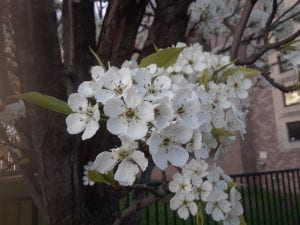
Almost everywhere you look, there they are – trees tall and short, festooned in blossoms, clothing the campus in white. A species popular in the horticultural trade, the Callery Pear grows quickly under a variety of conditions. This Asian native, a member of the rose family, has been bred into a variety of cultivars. Most share the characteristic white flowers, followed by glossy green leaves with pale undersides that turn a spectrum of colors, ranging from yellow through red to bronze, depending on the cultivar. The woody fruits are small and persistent. Birds will often eat the frost-softened fruits and disperse the seeds, making this tree a pest species in natural areas.
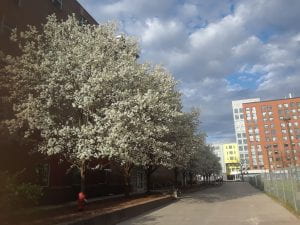
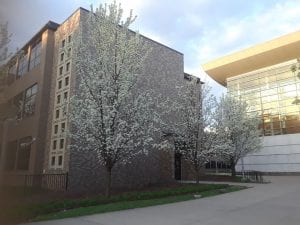
The Veil (Juneberry, Amelanchier spp.) 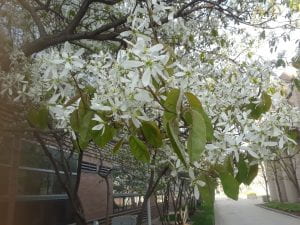
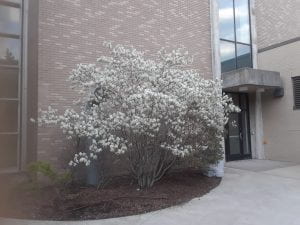 White flowers grace this delicate, bare-branched tree. A native understory resident, you might see them in woodlands where their blossoms catch the eye among the still drab browns and grays of late spring. The variety of names borne by this rose-family member – juneberry, serviceberry, sugarplum, wild plum, chuckley pear, shadbush, shadblow, Saskatoon – speak to the rich lore surrounding this tree, as well as the delectable fruits.
White flowers grace this delicate, bare-branched tree. A native understory resident, you might see them in woodlands where their blossoms catch the eye among the still drab browns and grays of late spring. The variety of names borne by this rose-family member – juneberry, serviceberry, sugarplum, wild plum, chuckley pear, shadbush, shadblow, Saskatoon – speak to the rich lore surrounding this tree, as well as the delectable fruits.
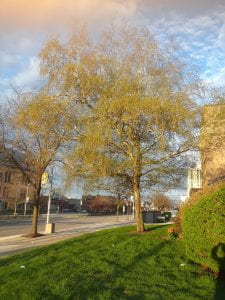 The Train (Yellow Birch, Betula alleghaniensis)
The Train (Yellow Birch, Betula alleghaniensis) 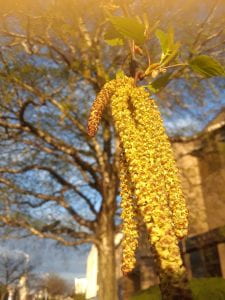
Our bride breaks from tradition here, opting for a train of cascading yellow catkins and tiny new green leaves. While this old tree is quite robust, the thin drooping twigs give the tree an airy look, just right for a bridal train. This tree attracts a number of browsers – cottontail rabbits and white-tailed deer among them – as well as yellow-bellied sapsuckers (migrating through at this time of year), and it serves as a larval host for mourning cloak butterflies. In all, an appropriate addition to our bride’s ensemble.
The Shoes
I thought about this for a while as I search campus for a suitable pair. We don’t grow lady’s-slippers on campus (yet), so I decided our bride should have no shoes. She is barefoot, the soles of her feet tickled by the sun-warmed soil, her toes luxuriating in the soft springiness of new, unmowed grass.
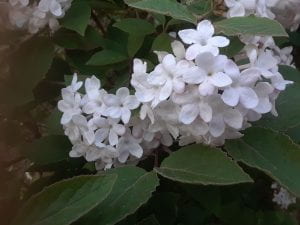 The Perfume (Burkwood Viburnum, Viburnum burkwoodii)
The Perfume (Burkwood Viburnum, Viburnum burkwoodii)
You round the corner near Science Hall, and you feel like you have stepped into some exotic paradise. The sweet, heady odor emitted by these small, creamy white and pink flowers transports you out of the noise and stink of the city, and is a fitting fragrance for our spring bride. Too soon, the flowers will fade away and be replaced by dark, glossy leaves on this sturdy shrub, and paradise will once again be lost.
Makeup (Tulips, Tulipa spp.) 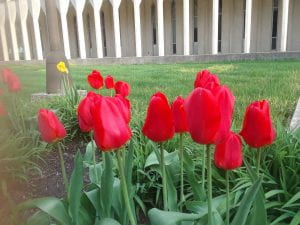
Our naturally beautiful bride needs no make-up, as dawn has given her a rosy blush. But what girl can resist a bold splash of color?! Not this one! The bright red of tulips is hard to miss on campus, and brings a note of cheer to the otherwise muted landscape around them. So, our demure nature beauty has opted for a daring bit of lipstick beneath her lacy veil.
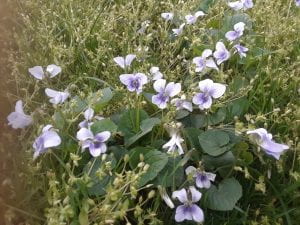
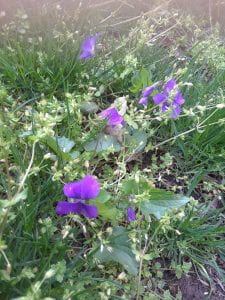 The Bouquet (Violets, Viola spp.)
The Bouquet (Violets, Viola spp.)
The humble violet will serve well for this posy. Associated with innocence, modesty and true love, they are befitting of our spring bride. Nestled among heart-shaped leaves, the tiny flowers are easily pressed and preserved, so our bride will have lasting memories, and “something blue” for her bridal wardrobe.
One Last Thing . . . 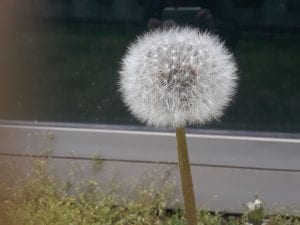
Though considered a “weed,” the dandelion has many important uses. Today, however, it will bring a note of whimsy as a source of wishes that will hopefully come true.
So our bride is dressed and ready, the flower girls await to strew her path with petals, but the procession cannot yet begin. Where are the bridesmaids? Still getting dressed in their finery . . .
